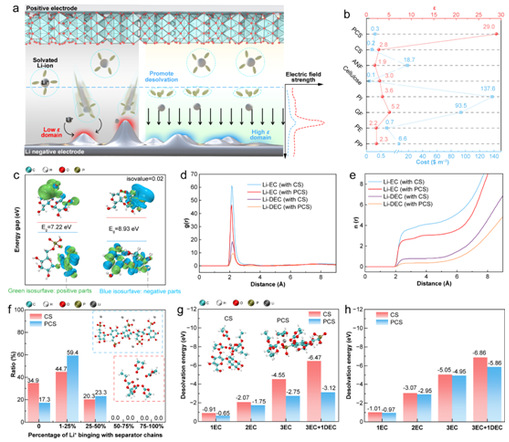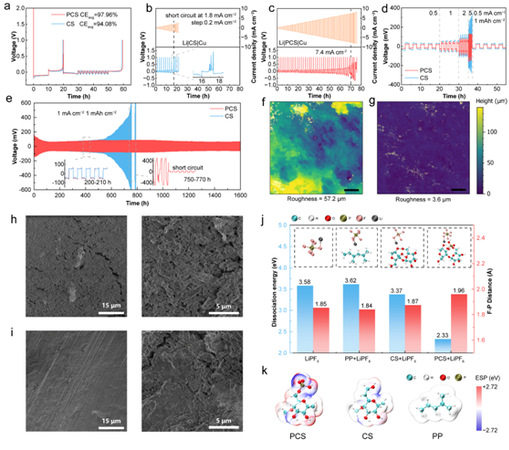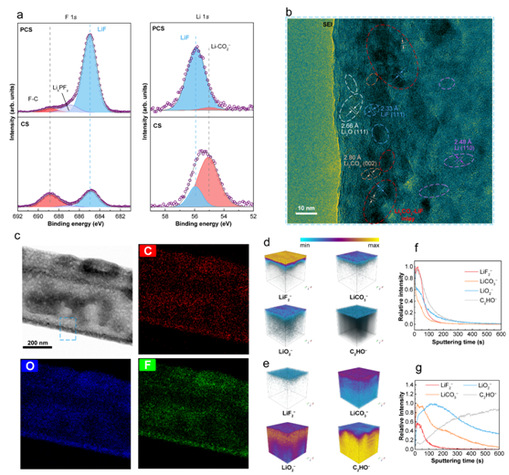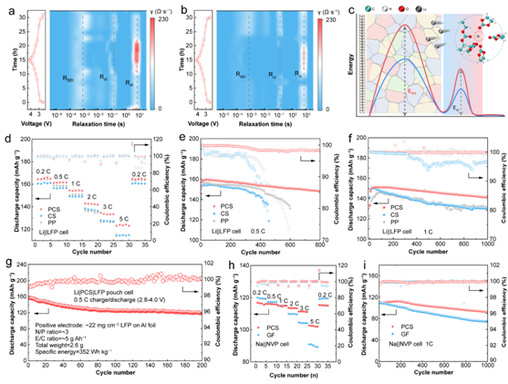Alkali metal batteries with high theoretical specific capacity and low reduction potential are very promising for next-generation energy storage systems. However, the growth of unstable solid electrolyte interfaces (SEIs) and dendrites on metal anodes poses a major challenge for the practical application of alkali metal batteries. Diaphragms, which are in direct contact with key components such as the negative electrode and electrolyte, play a critical role as both a ‘bridge’ and a ‘barrier’, and have the potential to address the challenges faced by alkali-metal batteries. Previous studies have focused on regulating electrostatic interactions, van der Waals forces and dipole-dipole interactions between the diaphragm and electrolyte components (alkali metal ions, solvent molecules and anions). However, their electrical properties have been neglected. During discharge of alkali metal batteries, the internal electric field typically exceeds 1 × 105 V/m. Such field strengths are sufficient to affect the diaphragm-negative interface as well as the interaction between the diaphragm and the electrolyte. Under strong electric fields, properties such as molecular polarizabilities and dipole moments change significantly, and changes in intermolecular interaction energies before and after the applied electric field are evident. This neglect leads to inaccurate characterization of the diaphragm-negative electrode interface and the interaction between the diaphragm and the electrolyte.
The team proposed a high dielectric constant fiber diaphragm composed of phosphatized cellulose. By introducing dielectric constant as a descriptor, the team explored the response behavior of fiber diaphragms with different dielectric constants under electric field, and investigated the effect of the high dielectric constant diaphragm on the negative electrode surface of alkali-metal batteries under the premise of uniform internal electric field. Under the internal electric field, the strong electron displacement polarization within the high dielectric constant diaphragm enhances the charge transfer kinetics and optimizes the solvation structure, which also induces the formation of a solid electrolyte interface rich in LiF and oligomers. In addition, high dielectric constant diaphragms can modulate the electric field density distribution and mitigate tip effects in metal electrodes. The application of high dielectric constant diaphragms enables alkali metal batteries to exhibit excellent electrochemical performance and cycling stability. At the same time, the wet molding process and the use of biomass materials as raw materials have enabled the large-scale production of high dielectric constant diaphragms. The results are published in Nature Communications under the title ‘Electron displacement polarization of high-dielectric constant fiberseparators enhances interface stability’. D. student Tao Zhang was the first author of the paper, and the corresponding authors are Meifang Zhu and Guiyin Xu from college of Materials Science ang Engineering, Donghua University.
Phosphorized fiber septa (PCS) with a dielectric constant as high as 29.0 can promote uniform distribution of the electric field at the negative electrode of alkali metal, thereby mitigating the tip effect. In addition, the band electron displacement polarization of high dielectric constant fibers under the action of electric field enhances the charge transfer kinetics and optimizes the solvation structure. In the presence of phosphorylated cellulose chains, the energy barrier for the removal of EC and DEC molecules from their solvated sheaths by [Li(EC)3(DEC)]+ (5.86 eV) is lower than that in the presence of pure cellulose chains (6.86 eV). Upon application of an electric field, the desolvation energy in the presence of PCS chains was further reduced to 3.12 eV. in contrast, the change in the desolvation energy in the presence of CS chains was negligible (6.47 eV). This is attributed to the strong electron transfer in the presence of PCS with high dielectric constant under the action of an electric field, which induces Li+ desolvation, a critical but not yet fully explored factor affecting cell performance.

(Figure 1: Design of high dielectric constant diaphragms)
Under the high dielectric constant fiber diaphragm, the half-cell battery demonstrated high Coulombic efficiency, stable deposition/stripping performance and excellent multiplicative performance, confirming that the high dielectric constant PCS endowed the alkali metal cell with fast reaction kinetics. DFT simulations indicated that the results suggest that the abundant phosphate groups in the cellulose backbone may significantly promote charge transfer and accelerate the dissociation of LiPF6 to generate LiF, which needs further fine exploration to verify the optimization mechanism of high dielectric constant fiber diaphragm on the chemical composition of the battery interface.

(Figure 2: Effect of PCS on Li+ deposition in metal negative electrodes)
The SEI structures formed by electrochemical deposition in the presence of high dielectric constant and low dielectric constant diaphragms were investigated separately using cryo-temperature electron microscopy (cryo-TEM) at sub-Å resolution. Li2O, Li2CO3 and LiF components were found. When a high dielectric constant PCS diaphragm is present, the SEI is observed to exhibit a mosaic structure with a large amount of LiF embedded in the Li2CO3 matrix. This mosaic structure promotes lithium ion transport while maintaining the low electronic conductivity of LiF. On the contrary, almost no LiF is observed when a low dielectric constant diaphragm is used, and the SEI structure is predominantly amorphous. The cryo-electron microscopy elemental distribution map shows the distribution characteristics of C, O, and F elements, which confirms the LiF enrichment phenomenon at the SEI interface. The above results confirm that the high dielectric constant PCS diaphragm can assist the formation of robust SEIs with low energy barriers driven by electric field, in which Li-ions diffuse mainly along the grain boundaries at a rate significantly faster than that of the conventional lattice diffusion.The results of TOF-SIMS and XPS are in agreement with those of the cryo-transmission electron microscopy results.

(Figure 3: Effect of high dielectric constant diaphragm on SEI chemical composition)
The DRT patterns of Li||LFP cells with PCS show lower interfacial phase transport impedance (RSEI) and charge transfer impedance (Rct) than CS, confirming faster charge transfer, higher conductivity, and more stable SEI in the presence of PCS than CS. The introduction of a high dielectric constant diaphragm reduces the desolvation energy of the alkali metal, thereby reducing Rct, while the LiF-rich SEI with low oligomer content reduces RSEI. As a result, the PCS-equipped Li|LFP and Na|NVP alkali metal batteries exhibit excellent multiplicative performance and cycling stability.

(Figure 4: Electrochemical performance of alkali metal cell with PCS)
CONCLUSION: Through the synergistic effect of the high dielectric constant diaphragm and the internal electric field of the cell, the team demonstrated a strategy to promote the diaphragm-negative electrode interfacial reaction for the construction of a stable alkali metal cell. Comprehensive simulation and characterization results show that the high dielectric constant diaphragm plays a key role in promoting the uniform distribution of the electric field density. In addition, the high dielectric constant PCS material undergoes a strong electron transfer under the electric field, which promotes the generation of LiF and reduces the energy barrier for lithium ion transport in SEI. Thanks to the electric field-driven electron displacement polarization effect, the interaction between the high dielectric constant diaphragm and alkali metal ions is enhanced, and the solvation structure and kinetic behavior of alkali metal ions are optimized, which effectively inhibits the side reactions of organic solvent molecules at the SEI interface. With the prepared high dielectric constant diaphragms, the cycle stability of both lithium and sodium metal batteries was significantly improved compared with those using commercial PP or GF diaphragms. These advances are of great significance for elucidating the reaction mechanism at the diaphragm-anode interface in the complex environment of batteries.
Original link: https://www.nature.com/articles/s41467-025-60256-9
